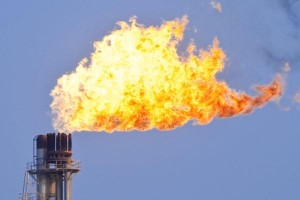Shale Oil 'Flaring' Is Dirty Secret Of U.S. Oil Boom
 Given the economic, energy and climate change challenges we face, you’d think it wouldn’t be necessary to write a column illustrating how it makes no sense to “flare” — literally burn up — $110 million worth of perfectly good natural gas each year without even using it to power a single light bulb.
Given the economic, energy and climate change challenges we face, you’d think it wouldn’t be necessary to write a column illustrating how it makes no sense to “flare” — literally burn up — $110 million worth of perfectly good natural gas each year without even using it to power a single light bulb.Yet that’s exactly what’s happening in North Dakota’s shale oil fields these days, as hydraulic fracturing, or “fracking,” liberates vast, once-uneconomic oil reserves — and billions of cubic feet of underground gas along with them. More than two million tons of carbon pollution is being flared into the air each year in this state alone.
The story behind this is not just one of short-sighted waste and environmental harm, but a pressing reminder of the business risks for oil companies that don’t get this hot new way of drilling for oil right.
Major investors are noticing those risks. In a letter sent this week to 21 of the industry’s largest shale oil producers, three-dozen investors representing $500 billion in assets wrote:
We are concerned that excessive flaring, because of its impact on air quality and climate change, poses significant risks for the companies involved, and for the industry at large, ultimately threatening the industry’s license to operate.
The financial and reputational risks for oil companies should be obvious. First, we’re supposed to be valuing precious domestic energy resources and our environment. But the New York Times reports that in North Dakota’s shale oil fields alone, “Every day, more than 100 million cubic feet of natural gas is flared this way — enough energy to heat half a million homes for a day.”
Investors see this as a clear bottom-line risk — serious enough to ultimately threaten the industry’s long-term profits as well as its license to operate.
“On a lifecycle basis,” the letter continues, “emissions from oil produced with high flaring rates may be comparable to those from Canada’s vast oil sands region” (a particularly high-carbon oil source.) “This could make it subject to penalties under clean fuel standards like those adopted by California, and being actively considered by the 13 Northeast states that are members of the Regional Greenhouse Gas Initiative. Such standards reduce the carbon intensity of fuel over time and limit the market (emphasis mine) for more carbon-intensive sources.”
The oil companies counter that, given the current lack of infrastructure for moving the gas from the oil wells, simply burning it off at the wellhead is the most economic course.
My question in response would be this: Given business, reputational, environmental and other risks, can’t the industry figure out a way to successfully capture this perfectly usable gas at a profit?
Before this practice mushrooms — as it’s poised to do — the time to curb this activity is now.
Fracking has opened up previously inaccessible oil fields in North Dakota, Texas, California, Colorado, Ohio and several other states, and flaring isn’t limited to North Dakota. Goldman Sachs recently forecast that the U.S. is on a path to become the world’s top oil producer in the next five years — a position it last occupied in 1973. Nearly all of this increased production would come from shale oil fracking.
If oil companies can’t figure out a way to tap this gas, then governments will come in with new potentially-punitive regulations — a process that will likely be messy given that fracking is mostly regulated by patchwork-quilt state rules.
In a world that’s approaching climate change tipping points — as yesterday’s new extreme weather global trends report from the Intergovernmental Panel on Climate Change makes clear — there is no place for this kind of heedless, useless pollution.
We can do better than this.
You can return to the main Market News page, or press the Back button on your browser.

